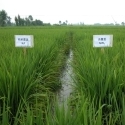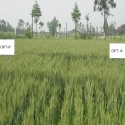15 Jan 2009
Balanced Fertilization Improves Soil Conservation in Sichuan
Balanced fertilization improves crop yield
Three-year field experiments were conducted to study effect of balanced fertilization on crop yield and soil erosion in Ziyang County, Sichuan province. Fertilizer treatments and their yields are given in Table 1. Results showed that the study soil was deficient in N, P and K, but N was most limiting. The average crop yield over three years decreased by 82.9% without N, by 23.9% without P, and by 12.2% without K fertilizer. Without application of Zn, the crop yield only decreased 2.8%.
Table 1. Crop yield in three years as affected by different fertilizer treatments (kg/ha)
Treatments | 1st year | 2nd year | 3rd year | Average | Relative yield (%) |
NPK | 6990 | 10275 | 7785 | 8355 | 100 |
No fertilizer | 1185 | 1815 | 735 | 1245 | 15 |
PKZn | 1215 | 2025 | 1050 | 1425 | 17.1 |
NKZn | 5445 | 8190 | 5445 | 6360 | 76.1 |
NPZn | 6975 | 8580 | 6450 | 7335 | 87.8 |
1/2N+PKZn | 5985 | 8085 | 6705 | 6930 | 82.9 |
NPKZn | 7620 | 10245 | 7905 | 8580 | 102.8 |
N2P2KZn | 7245 | 9675 | 7530 | 8145 | 92.6 |
Balanced fertilization reduces soil erosion
Balanced fertilization not only increased crop yield but also prevented soil and water loss (Table 2). Balanced fertilization reduced soil loss by improving crop growth. Improved crop shoot growth can shed rain drops that directly impact the soil surface and improved root growth can hold soil more tightly against rain wash.
Table 2. Effect of different treatments on soil erosion and water loss
Balanced fertilization reduces nutrient loss
Nutrient loss through soil erosion is detected in two forms: a soluble form in run-off water and mixed form (exchangeable, slowly available, and mineral form) in sediments (Table 3). It is clear that plant cover is crucial to protect both soil and nutrient loss from erosion. Therefore, when soil is uncovered (naked) by crop, this causes the highest nutrient loss. The balanced fertilization treatment improved crop growth and also produced better land cover; thus, less nutrient loss and better nutrient efficiency. Even when there was no fertilizer applied, that is, soil nutrient level in the no fertilizer treatment was the lowest among the treatments, the nutrient loss was the second highest only after the naked soil treatment.
Table 3 the rate of nutrient loss with different treatments (kg/ha)
The extension of balanced fertilization is very practical and of great significance against soil erosion and nutrient loss in the hilly areas and those with erosive soil types. It is a proven technology that can produce best crops, best economic returns for farmers, and a sound environment.




